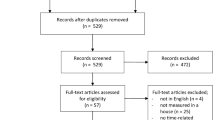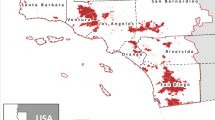Abstract
SMOKE and sulphur dioxide levels are measured by the Warren Spring Laboratory at many sites in Great Britain1, but little information is collected in rural areas. Here we describe a method for estimating atmospheric pollution which can be applied in most areas where trees are found.
This is a preview of subscription content, access via your institution
Access options
Subscribe to this journal
Receive 51 print issues and online access
$199.00 per year
only $3.90 per issue
Buy this article
- Purchase on Springer Link
- Instant access to full article PDF
Prices may be subject to local taxes which are calculated during checkout
Similar content being viewed by others
References
The Investigation of Air Pollution, Annual Summaries, Warren Spring Laboratory (Department of Trade and Industry, 1964 to present).
Daines, R. H., in Current Topics in Plant Sciences (edit. by Gunckel, J. E.) (New York, 1969).
Skye, E., Acta phytogeogr. suec., 52, 1 (1968).
Gilbert, O. L., New Phytol., 67, 15 (1968).
Lees, D. R., Creed, E. R., and Duckett, J. G., Heredity, 30, 227 (1973).
Meteorological Office, Climatological Atlas of the British Isles (HMSO, London, 1952).
Hawksworth, D. L., and Rose, F., Nature, 227, 145 (1970).
Rose, S., and Pearce, L., New Sci., 53, 376 (1972).
Author information
Authors and Affiliations
Rights and permissions
About this article
Cite this article
CREED, E., LEES, D. & DUCKETT, J. Biological Method of Estimating Smoke and Sulphur Dioxide Pollution. Nature 244, 278–280 (1973). https://doi.org/10.1038/244278a0
Received:
Issue Date:
DOI: https://doi.org/10.1038/244278a0
This article is cited by
-
Regularity and differentiation within the structure of brain postsynaptic densities
Journal of Neurocytology (1981)
-
Synaptic junctional glycoconjugates from chick brain
Neurochemical Research (1980)
-
Separation of specific fractions of synaptosomes by affinity chromatography
Experientia (1978)
Comments
By submitting a comment you agree to abide by our Terms and Community Guidelines. If you find something abusive or that does not comply with our terms or guidelines please flag it as inappropriate.



